ISSUE 08 CELEBRATING INNOVATION PROTECTING INVENTIONS, COMPANIES AND BRANDS SINCE 2007 Updated UKIPO practice, find out more inside… 12-15 Success! Albright IP defends patent against revocation 22-23 IP in the entertainment industry 08-11 The inventor –interview with Louise Sanders
04-06
Updated UKIPO practice: Address for service requirements
07
Help! Someone else has registered my domain name!
12-15
Success! Albright IP defends patent against revocation
16-18
Careers in IP – Joel Weston, Trade Mark Attorney, talks about his journey into the world of IP
19
Opting out of the Unified Patent Court
20-21
Duku celebrating 10 years 22-23
IP in the entertainment industry 24
Can you patent software? 25-27
Albright IP news
WE TALK TO LOUISE SANDERS, WHO DELVED INTO THE WORLD OF INVENTION WHEN SHE BECAME A MOTHER.

08-11
Also available online Figure 1 Magazine is published by: Albright IP, County House, Bayshill Road, Cheltenham, Gloucestershire GL50 3BA
T: +44 (0)1242 691801 E: info@albright-ip.co.uk www.albright-ip.co.uk
©Copyright Albright IP 2023
Contents
02 FIGURE 1 MAGAZINE | ISSUE 08
Welcome to Figure 1
IT’S BEEN A BUSY FIRST HALF OF THE YEAR FOR US AT ALBRIGHT IP, AND WE’RE PROUD TO INTRODUCE OUR FOUR NEW BOARD DIRECTORS: CLOE LOO, FREDERICK NOBLE, MARC MAIDMENT AND DR WILLIAM DOHERTY.
Their appointments highlight our commitment to delivering director-led work, a key aspect of our service.
This edition showcases our recent triumph defending a patent against revocation and features the inspiring story of Louise Sanders, an inventor mother. It brings attention to the new Address for Service requirements for International Trade Mark and Design Registrations, a point not to be missed!
Our spotlight is on Joel Weston, our Associate and Trade Mark Attorney, who shares his intriguing career journey. We also discuss the option of opting out of the Unified Patent Court, crucial for your IP strategy.
We’re proud to share that Albright IP has once again been recognised as one of the Top 50 filers of UK Trade Mark applications by the Chartered Institute of Trade Mark Attorneys (CITMA).
Finally, we celebrate the remarkable accomplishments of Charlie Heal, Dr Ciara Felix and Alysia Draper, who have successfully passed a series of foundation exams on their journey towards qualification.
We hope you enjoy this edition of Figure 1, filled with insightful articles and updates from the world of IP.
Robert Games MANAGING DIRECTOR
We’re proud to share that Albright IP has once again been recognised as one of the Top 50 filers of UK Trade Mark applications by the Chartered Institute of Trade Mark Attorneys (CITMA).
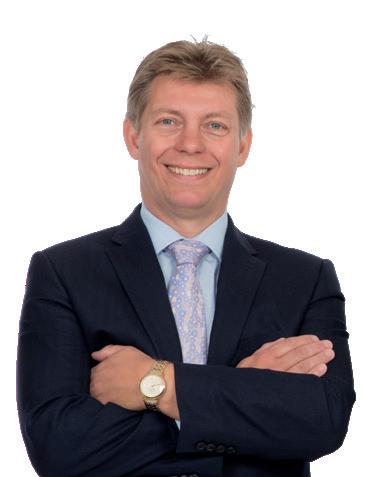
03 www.albright-ip.co.uk
Updated UKIPO practice: Address for service requirements for International Trade Mark and Design Registrations designating the UK
A NEW PRACTICE RULE AT THE UKIPO REQUIRES A UK-BASED ADDRESS FOR SERVICE TO BE PUT IN PLACE FOR UK DESIGNATIONS OF INTERNATIONAL TRADE MARK & DESIGN REGISTRATIONS.
Julia House TRADE MARK DIRECTOR

At present, there is no strict requirement for a UK address for service to be in place for all direct national Applications/ Registrations, but there is a strong push towards this being insisted upon.
The intention behind the practice change is to bring the UK into line with the EUIPO approach and accords with the end of the extended post-Brexit transition period, due to end on 31 December 2023.
Failure to provide a UK address for service may result in a challenged registration being cancelled.
04 FIGURE 1 MAGAZINE | ISSUE 08
Up until recently, the UKIPO attempted to serve papers in contentious proceedings to overseas owners by post, but it has become evident that procedural deadlines could be missed without these having come to the attention of the owner, or their overseas representative.
As a consequence, and following the recent decision of the Appointed Person (AP) in Tradeix Ltd v New Holland Ventures Pty Ltd BL (O/681/22) (Marco Polo Case), the UKIPO will now require a local address in the UK before formally serving documents in contentious proceedings relating to UK designations of International Trade Mark or Design Registrations.
Failure to provide a UK address for service may result in a challenged registration being cancelled or an opposed Trade Mark or Design being treated as withdrawn, as the procedural papers may not be served in time.
In summary:
Previously, the UKIPO would send papers in contentious proceedings to the proprietor at the foreign address, and they would be given two months to defend.
Now the UKIPO will notify the foreign address and give them one month to appoint a UK Address for Service, after which the papers will be “served”, with the appointed UK representative receiving a two-month deadline to defend.
To avoid an issue, it is recommended that a genuine UK address for service be put in place for all UK designations as a routine formality, and in any event, prior to any proceedings being contemplated or defended.
Our recommendation:
To eliminate unnecessary risk, we strongly recommend that you take steps to appoint a UK representative for your client’s UK designations of International Trade Mark and Design Registrations, and take the same action for direct national UK Trade Mark and Design Registrations. This will avoid the complex reporting process set out earlier, that could result in rights being lost just through non-compliance or missed deadlines.
Albright IP will be pleased to step in as UK representatives for your clients’ Trade Mark and Design rights.
For more information, please contact our Trade Mark team trademarks@albright-ip.co.uk or our Design team designs@albright-ip.co.uk
The new practice rule may seem complex, but the mechanics behind it will hopefully become more straightforward once it has been in place for a while, especially if most UK designations have a UK representative in place before any proceedings arise. Hence, a proactive and timely action to appoint a UK representative now is to be recommended.
05 www.albright-ip.co.uk
Up until recently, the UKIPO attempted to serve papers in contentious proceedings to overseas owners by post, but it has become evident that procedural deadlines could be missed.
New approach for invalidation, revocation on the grounds of non-use, revocation on grounds other than non-use, and rectification:
Where a UK designation is challenged without a valid UK address for service in place, the UKIPO will issue a preliminary letter directing the proprietor to provide a valid service address within a period of one month from the date of the letter alongside their intention to oppose the application for invalidation, revocation or rectification. Failure to do so will result in the UKIPO treating the UK designation as undefended.
A letter will be issued notifying the proprietor of the UKIPO’s intent to treat the challenge as undefended and possibly to declare the right invalid or revoked. This letter will be sent to the non-UK address currently on file and will give them a 14-day period in which to reply. Failure to respond will result in the UKIPO issuing a decision on the undefended challenge. If the UK designation is declared invalid, revoked or rectified, WIPO shall be informed accordingly.
New approach for oppositions against published International Registration with a designation in the UK:
For Oppositions against pending UK designations, a ‘notice of provisional refusal based on an opposition’ will continue to be sent to WIPO, who will then relay the information to the applicant using the non-UK address for service. WIPO’s actions will continue to constitute effective service of the opposition.
At this stage, the UKIPO will then send a letter to the applicant duplicating the information relayed by WIPO, namely that the two-month period to initiate a defence has been activated and to confirm that a valid UK address for service is required.
Where an applicant submits a counterstatement and a valid UK address for service, the proceedings will continue in accordance with the standard practices. If only the counterstatement is filed (and no appointment request), the UKIPO will issue another letter to the address held by WIPO requesting a valid UK address for service to be in place within one month of receipt of the letter. In cases where the applicant fails to be attentive by providing a valid UK address for service, the UKIPO will issue WIPO with a final notice of refusal. The Opposition will be treated as if no counterstatement was supplied. It is, however, important to note that this consequence will only apply to the goods and/or services against which the opposition was directed.
Failure to do so will result in the UKIPO treating the UK designation as undefended.
In cases where the applicant fails to be attentive by providing a valid UK address for service, the UKIPO will issue WIPO with a final notice of refusal.
06 FIGURE 1 MAGAZINE | ISSUE 08
Help! Someone else has registered my domain name!
REGISTERING AN INTERNET DOMAIN NAME IS CHEAP AND SIMPLE. BUT WHAT HAPPENS IF SOMEONE GETS THERE FIRST WITH YOUR BUSINESS NAME? IT WOULD BE BETTER TO AVOID THE PROBLEM ALTOGETHER, AND WE WOULD ALWAYS RECOMMEND CHECKING DOMAIN AVAILABILITY AND GETTING TRADE MARKS REGISTERED IN ADVANCE OF A PUBLIC REBRAND.

For longer than most companies have even had websites, speculators have been trying to snap up domain names, often in the hope of selling them back to somebody who actually has a real business associated with that name for a great deal more than the initial cost of registration.
Fortunately, this activity is recognised as abusive and action can be taken by businesses, especially if they have registered trade marks, to force transfer of these domains.
The rules and procedure vary slightly for the different top level domains, i.e. based on whether it is a .com, .co.uk, etc. For UK domains you will need to show that firstly you have rights in the name registered, and secondly that the registration is abusive.
Having a registered trade mark will help a lot, although unregistered common law rights to prevent use of a similar name can also count.
There are a number of reasons that the registration could be abusive. If the person who registered has tried to sell it to you for a large amount of money that would be a strong ground. A registration will also be abusive if its use infringes your trade mark, among other things.
Procedurally, your case needs to be set out in full at the outset. You get one chance to get it right and so you need to take care to make sure that you put in evidence to prove the criteria are met – there is no opportunity to put in extra evidence later.
If you have a problem with an abusively registered domain name, or any other wrongful use of your brand, feel free to get in touch and we will see if we can help.
Frederick Noble PATENTS DIRECTOR
For UK domains you will need to show that firstly you have rights in the name registered, and secondly that the registration is abusive.

07 www.albright-ip.co.uk
When finance and innovation collide: From financial services to revolutionising prams

Dissatisfied with the limitations of traditional prams, she embarked on a mission to create a revolutionary ‘smart’ pram. However, her journey faced numerous obstacles, including a pandemic-induced manufacturing setback and the complex world of patents. Despite the challenges, Louise remains determined to bring her innovative pram to market…
 FIGURE 1 TALKS TO LOUISE SANDERS, A FINANCIAL SERVICES AND ADVERTISING PROFESSIONAL, WHO FOUND HERSELF DELVING INTO THE WORLD OF INVENTION WHEN SHE BECAME A MOTHER.
FIGURE 1 TALKS TO LOUISE SANDERS, A FINANCIAL SERVICES AND ADVERTISING PROFESSIONAL, WHO FOUND HERSELF DELVING INTO THE WORLD OF INVENTION WHEN SHE BECAME A MOTHER.
08 FIGURE 1 MAGAZINE | ISSUE 08
“My background is in financial services and advertising – absolutely nothing to do with making or inventing things,” admits Louise, the mastermind behind the EBITSU pram, a new take on the traditional pram.

“I was very much the archetypal office worker, with a career in the financial services sector and very definitely not involved in anything to do with inventions, engineering or manufacturing.”
But all this was soon to change with the birth of her first child.
Like many other families, a pram was high on the list of purchase priorities on Louise’s ‘new mum’ shopping list. However, she soon discovered some shortcomings in this essential piece of kit.
“When my daughter was born, I was really surprised at how basic and limited prams were,” she recalls. “Nothing was built in, everything was rickety and it seemed like everything you actually needed only came as a separate accessory.
“When you’re tired or the weather is changeable and you need to have all the different bits to cope with – rain, bright sunshine and so on – it’s so much to have to deal with and I thought surely all this could simply be built in!”
It was from this frustration that Louise’s product concept was born –a ‘smart’ pram.
“I did some research around the market – over and above what I’d already discovered as a first-time mum. I got a pen and paper and sketched out what I wanted my perfect pram to look like and what I thought the features should be.”



Recognising she lacked the necessary engineering expertise to turn the paper concept into a physical reality, Louise began a search for a product design and development agency, and hired Duku Product Design – Albright IP’s sister company.
Says Louise: “I worked very closely with Duku to take the concept to technical specification stage. I really enjoyed taking a piece of paper with my dreadful sketching on into something that you could actually make. Seeing the prototypes come to life and actually seeing my design work and the features and functionality working in real life – even though it was a fairly rudimentary prototype, particularly the early ones –was amazing!
“I then met with a Dragon from Dragons’ Den, who was very keen on investing, but the unit price he wanted to achieve meant really scaling back all of the features. That wasn’t something I wanted to do and not something that I thought would wow the market.
“Instead, we partnered with a Swedish company to help with testing.”
I got a pen and paper and sketched out what I wanted my perfect pram to look like and what I thought the features should be.
09 www.albright-ip.co.uk
As we’ve not been able to move onto the manufacturing stage yet, it’s the IP that is currently the value in the business. It’s critical that we have this asset under our belt early on, and it’s allowed us to have some options to manoeuvre differently.

Sadly, before Louise could take things to the next stage, Covid arrived. “This had an enormous impact on our plans as the pandemic led to massive changes in pricing, and created a worldwide shortage of electronic components.
“This in turn meant we’ve not been able to hit the manufacturing stage as we’d hoped.”
This unforeseen interruption did enable Louise to focus on another area that was unknown territory for her – the world of patents.
“Albright IP has helped me understand the patent process as well as giving me some introductions to licensing,” she said.
“Albright did a great job in making the whole process as understandable as possible for someone without any legal background or appreciation of what needs to happen and the different stages involved.
“I was surprised at all the patent law variations that exist across different territories, and about the ins and outs of trying to have one patent globally. It can be quite expensive. It made me realise the importance of identifying which territories are important to you and why. I’ve recognised I did make some mistakes along the way – for example, we invested in Taiwan thinking that it might be territory that we actually manufactured in, but that’s not going to be the case.
“Albright IP have been great partners and have helped me unravel all this and get a much better appreciation of what I need to think about and do.”
10 FIGURE 1 MAGAZINE | ISSUE 08
What then, is next for the pram concept?


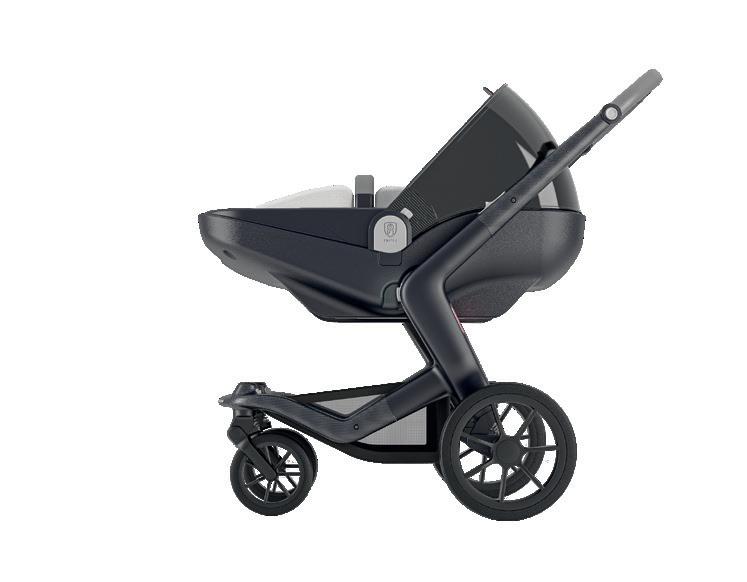
“As we’ve not been able to move onto the manufacturing stage yet, it’s the IP that is currently the value in the business. It’s critical that we have this asset under our belt early on, and it’s allowed us to have some options to manoeuvre differently. And we do have some interested third parties in the patent.”
Louise does have some other business irons in the fire but won’t be forgetting her pram plans. “ When we were looking to take it to manufacture, shipping had quadrupled in price," she recalls.
“But hopefully over the next 12-24 months I’ll know whether we’ve actually got a licence secured, or whether we will need to go back to the drawing board and find some new manufacturers that can take it to market for us.”
As she navigates the complexities of the patent process and explores potential manufacturing partnerships, Louise remains resolute in her mission to bring her vision to parents around the world. The journey may be long, but the promise of seeing her pram on the shelves keeps her motivated and excited for what lies ahead.
Albright has enjoyed being involved with this project, from identifying the unique and innovational aspects of Louise’s ideas, which at this time have resulted in three granted British patents, one Taiwanese patent, as well as US and European pending applications. This provides a great base for her licensing opportunities going forwards.
11 www.albright-ip.co.uk
FIGURE 1 MAGAZINE | ISSUE 08
Success! Albright IP defends patent against revocation
 Marc Maidment PATENTS DIRECTOR
Marc Maidment PATENTS DIRECTOR
WHAT SHOULD YOU DO IF YOUR PATENT COMES UNDER ATTACK? SIMPLE – CONTACT YOUR PATENT ATTORNEY AT ALBRIGHT IP! THAT IS EXACTLY WHAT ONE OF OUR CLIENTS DID, AND WE ARE PLEASED TO HAVE SUCCESSFULLY DEFENDED HIS GRANTED PATENT GB2502993 AGAINST AN ATTACK BY THE FORMER PATENT LICENSEE, BOLLARD PROOF, AS DECIDED BY THE UK INTELLECTUAL PROPERTY OFFICE (UKIPO).

12
How did it all start?
We originally drafted and filed the patent back in 2012. The patent relates to a bollard load-testing apparatus (Fig.1) which can be adjusted to apply loads at different angles. This provides a better way of assessing whether marine bollards are in good enough condition to handle the high loads applied by ship mooring lines. Fig.1 shows the patented invention.
Conventional bollard load-testing devices were nothing like the claimed invention, so the grant procedure was fairly straightforward and the patent was granted in 2016.
Of course, getting a granted patent is just one step along the road to commercial success. The patent was licensed in 2019 in an effort to bring this important new technology to market. Unfortunately, the licensee didn’t hold up their end of the bargain, and they instead tried (and failed) to revoke the patent at the UKIPO, beginning in January 2022.

Fig.1: The patented invention can apply load to a marine bollard at different angles.
How does patent revocation work?
A patent is intended to protect an invention which is new and nonobvious over other things which are already publicly known. Patent Offices search and examine patent applications in an effort to ensure that they don’t grant patents for known technology or obvious variations of existing technology. Of course, Patent Offices are not infallible and they don’t always find everything that is relevant to patentability.
If that happens, it is possible to get a patent revoked by applying to the court or to the UKIPO. There are pros and cons to each forum. Revocation at the UKIPO can often be seen as safer and cheaper, because if you lose then the costs award against you is substantially lower than if you litigate in court.
The patent was licensed in 2019 in an effort to bring this important new technology to market.
13 www.albright-ip.co.uk
A testing time for the patent
In the case at hand, the licensee found a test rig (Fig.2) developed in the USA around 2007, i.e. prior to the patent filing date. Instead of having any sort of angle-adjustable frame, the prior art device was designed purely to test bollard load capacity at a single load angle. An important difference was that it used a beam on a greased ramp to transfer the load to the bollard.
Nonetheless, the testing arrangement described was just about close enough to pose a risk to the patent, so we filed a post-grant amendment to limit the patent claims. This made it clear that the patent only related to an angle-adjustable load-testing device, with a pivotable second frame adapted to apply the load, still providing a commercially useful scope of protection. Whilst this clearly distinguished the patent from the

new prior art, the (by that stage, former) licensee chose to continue the revocation action anyway, perhaps thinking that they could still revoke the patent even if it meant a Pyrrhic victory for them.
A pivotal decision –the patent pulls through
Following evidence rounds, including expert evidence where the licensee engaged their own director as their expert witness (despite potential conflict of interest), the case went to a hearing before the UKIPO in November 2022.
A little over two months later, and just under one year since the revocation action was filed, the Hearing Officer issued their decision to maintain the patent using the exact amendments that we had filed months earlier.
An important difference was that it used a beam on a greased ramp to transfer the load to the bollard.
14 FIGURE 1 MAGAZINE | ISSUE 08
Fig.2: The prior art test rig as shown in the UK IPO’s decision BL O/0052/23.
The crux of the matter was to frame the invention in the right way. The licensee attempted to argue that it would be obvious to incorporate a pivot arrangement into the known test rig, but this hinged on a faulty assumption that it could be simply ‘put into’ the existing working arrangement. Just because pivot joints are well-known doesn’t mean it is obvious to put them everywhere! The prior art device didn’t have any change in the angle of load application at all, and only made passing reference to ‘minor modifications’ needed for a change of angle (i.e. bolting in a different greased ramp at a different angle), hardly enough to invalidate the patent.
The Hearing Officer agreed with us that the claims as amended were not obvious, and that the patent should remain granted and in force. It can be easy to fall into the trap of thinking that something is obvious when actually it isn’t; at least, not obvious when it comes to patenting. Now, the patent is ‘fireproofed’, and more valuable as a result.
If you have a granted patent in need of defence, or if you wish to attack a granted patent, we would be pleased to assist. And, on a related note, if you have a new invention but you are wondering whether it’s obvious or not, it is worth getting an attorney’s input – a skilfully drafted patent specification can make all the difference in getting (and keeping) a granted patent.
Just because pivot joints are well-known doesn’t mean it is obvious to put them everywhere!

15 www.albright-ip.co.uk
Joel Weston
A CAREER IN IP CAN BE BOTH FASCINATING AND REWARDING, EVEN IF IT ISN’T A CAREER PATH THAT YOU SET YOUR SIGHTS ON FROM THE START. IN FACT, AS ALBRIGHT IP ASSOCIATE AND TRADE MARK ATTORNEY JOEL WESTON SHOWS, YOU CAN BE SUCCESSFUL EVEN IF YOUR ROUTE INTO THE FIELD DOESN’T FOLLOW THE STANDARD PATH…

16 FIGURE 1 MAGAZINE | ISSUE 08
ASSOCIATE CHARTERED TRADE MARK ATTORNEY LLM, LLB (Hons)
Q
How did you get into IP & Trade Marks?
As I cast my mind back, I would certainly say my journey into IP and Trade Marks didn’t follow the standard route.
I left school at 16 without many GCSEs. I really didn’t know what I wanted to do, but as I’d always been good at science, I settled on studying that at college. This ultimately led me to studying Chemistry at university. But, at 18, I really wasn’t in the right headspace to commit myself to university. So, I left after the first year with quite bad grades and started full-time work.
Since the age of 16 I’d worked in kitchens part-time, so I picked this up full-time once I’d left that first year at university. By 2012 I’d worked in kitchens for five years and thought I really need to do something more than this. By the time I’d made this decision it was very late in the academic year and therefore the only places available at university were clearing positions. I’ve always been a big believer in studying a STEM or practical degree and the only two available were Chemistry or Law. I really didn’t want to go back to study Chemistry again, so I thought why not give something different a try and study law.
Q Did you always want to work in IP?
My first exposure to IP was in my second year of university where I picked an IP module. I really enjoyed that and found that I was good at it. I thoroughly enjoyed studying all aspects of law though, so I wasn’t entirely sure what area I wanted to specialise in.
IP was always one that stood out to me though and in my final year I did my dissertation on IP and copyright. Throughout university, they say you’re either a barrister or a solicitor, there was no mention of Trade Mark or Patent Attorney as a career choice; I didn’t find that out until I started my Masters.
I went on to study a Masters in Commercial Law thanks to being awarded a bursary designed to help students that were from underprivileged backgrounds that had done well at university. It was during my masters that I picked IP modules again and when a career in Trade Marks or Patents was first mentioned.
Within the IP module I studied Patents, Copyright and Trade Marks, and that was really my first exposure to Trade Mark law. I just found it interesting and gelled with it.
Q What’s been the biggest challenge so far in your career?
The biggest hurdles were securing a trainee position and actually qualifying. Throughout my studies I’d been working 30–40 hour weeks in kitchens, so I just needed someone to give me a chance in a trainee office role. Securing that role without a referral was really challenging.
I think the route of qualification isn’t easy, I imagine it’s the same for any lawyer. It takes a long time. From starting my degree to qualifying, it took 10 years. It wasn’t quick, but just getting over those final exams, I think is probably the biggest challenge.
It was during my Masters that I picked IP modules again and when a career in Trade Marks or Patents was first mentioned.
17 www.albright-ip.co.uk
Once I was finally on the right path, things have progressed relatively quickly; in the space of 18 months, I had gone from an Administrator to being a Part-Qualified Attorney.
Q How has your role changed / grown at Albright IP?
It’s changed massively. I started as a Trade Mark Administrator and after six months I was made a trainee, which was earlier than expected as I was doing well. Once I’d finished the first part of the training, I was then made a Part-Qualified Attorney. Once I was finally on the right path, things have progressed relatively quickly; in the space of 18 months, I had gone from an Administrator to being a Part-Qualified Attorney.
Q What’s your favourite aspect about what you do?
Probably the speed and variety of it. I could be working on a complicated infringement matter one moment and advising a client on a domain dispute the next. Then I could be working on a contentious tribunal matter before the Registry or assisting a phone enquiry that doesn’t even know what a Trade Mark registration is. It’s very varied.
Q What do you enjoy most about working at Albright IP?
The beauty of working for Albright IP is that I’m working directly with the directors and partners. Being able to work directly for the business owners has been a big benefit. We also advise a wide array of clients from different sectors, which keeps things interesting.
Q What would your advice be to anyone looking to get into IP or Trade Marks?
Persistence, hard work and dedication. It takes a long time. Some longer than others; I think maybe my route was particularly slow. I guess it depends on what background you’ve come from, but internships and experience at law firms really helps; so, applying for vacation schemes or sending emails out for voluntary work is always good and is what I’d recommend.
Q If you weren’t in IP, what would you be doing?
I think I’d probably be in a trade such as a plumber, mechanic or electrician.
Q Finally, what do you get up to outside of work?
I love cars. Old cars. I love tinkering with my old BMW, my old Audi, playing around with it on the drive. And I play the guitar, so I’m quite into music. I love snooker too.
18 FIGURE 1 MAGAZINE | ISSUE 08
Opting out of the Unified Patent Court: Safeguarding your Intellectual Property Rights
AT ALBRIGHT IP, WE ARE COMMITTED TO KEEPING YOU INFORMED WHEN IT COMES TO PROTECTING YOUR IP ASSETS. AS MANY OF YOU KNOW, THE EUROPEAN PATENT NOW HAS AN EU COMPONENT, CALLED THE UNITARY PATENT, AND A BRAND-NEW PATENT COURT CALLED THE UNIFIED PATENT COURT (UPC).
The UPC represents a significant development in European IP law, aiming to establish a unified approach to patent protection across participating countries.
However, we understand that some clients may have concerns about the potential vulnerability of their patents to third-party attacks, which could result in the invalidation of their rights across multiple European jurisdictions.
To address these concerns, we would advise you to consider the possibility of opting out of the UPC.
Are you in or out?
By opting out, you can maintain control over the enforcement and protection of your IP rights within individual European jurisdictions. This allows you to handle any IP disputes related to your patents in the national courts of your choice, rather than being subject to the jurisdiction of the UPC.
To reduce the risk of competitors pre-emptively filing for revocation of your European patent at the UPC, you should opt out as soon as possible.
If you have any questions about opting out of the UPC, our team is fully equipped to guide you through the opt-out procedure and provide tailored advice to safeguard your IP rights.
We understand the complexities and potential risks associated with the UPC and are dedicated to ensuring that your interests are protected.
We encourage you to make an informed decision regarding the UPC and its implications for your IP.
Your IP assets are invaluable, and their protection is of utmost importance to us. By remaining proactive and well-informed, you can make the best decisions for your business and IP strategy.
Robert Games MANAGING DIRECTOR

19 www.albright-ip.co.uk
Duku celebrates 10th anniversary

ALBRIGHT IP’S SISTER COMPANY, DUKU, CELEBRATES ITS 10TH ANNIVERSARY THIS YEAR AFTER HELPING OVER 500 START-UPS, ENTREPRENEURS AND LARGE-SCALE BUSINESSES TURN THEIR PRODUCT IDEAS INTO EYE-CATCHING DESIGNS SINCE ITS CREATION IN 2013.

Just a stone’s throw from our office, their dedicated team of experienced designers are committed to creating innovative design solutions that stand out from the crowd. The design agency has worked with clients from across a wide range of industries, including Whyte mountain bikes, Spirax Sarco and the NHS.

20 FIGURE 1 MAGAZINE | ISSUE 08
Founding Directors Andrew Aylesbury & Alex Lee
Duku win Innovate UK Inclusive Innovation Funding Award
The Duku team were delighted to win £50,000 in June as part of the Government-backed Innovate UK Inclusive Innovation Award.
Duku has a strong history of inclusive design, working on several previous Innovate UK research and design projects targeting inclusivity for those with limited mobility. The learnings from these projects have been transferred into common practice for all of their work, influencing products from mobility scooters to inclusive library scanning, assistive language learning, home assistance products and award-winning medical products.
It is a great honour to receive this award. The funding received will make a significant difference, ensuring we can continue to use our state-of-the-art prototyping equipment to bring inclusive design innovations to life.
Andrew Aylesbury, Director
Next steps
The £50,000 received as part of the award from Innovate UK will help finalise the development of the 22kW public variant of their fully accessible EV charger through the company’s sub-brand, Duku EV. It is hoped that its unique automated cable system and ability to accept tap-to-pay payments will help to address issues in electric vehicle charging accessibility, allowing everybody the opportunity to make the transition to electric vehicles, including those with a disability.




Visit www.duku.co.uk to learn more about the award and how their team of experts can help bring your idea to life.
Duku EV Home Charger Accessible EV charger
Quingo Flyte Mobility scooter docking station
Kitt Medical A kit to combat anaphylaxis
21 www.albright-ip.co.uk
The public EV charger during disabled driver testing
Fantasy Realms: A look at IP in the entertainment industry
Dr William Doherty PATENTS DIRECTOR

WOULDN’T IT BE BETTER TO LIVE IN A FANTASY WORLD? A MUSHROOM KINGDOM, FOR EXAMPLE. NEVER FEAR! NINTENDO ARE HERE TO HELP.
Not satisfied with taking you to a virtual world through your games console, and filling your home with plastic facsimiles, it seems as though the Nintendo Cinematic Universe has now invaded the multiplex (and the singles chart). What’s next? Nintendo theme parks?
Maybe wizards are more your sort of thing? Daniel Radcliffe might be well into his thirties now, but the Harry Potter movies are still driving streaming traffic to HBO Max. If that wasn’t enough, there’s a new TV series in production, to go with the recently released Hogwarts Legacy and forthcoming Quidditch Champions to dive into on your PC. There’s even a deck-building co-operative board game to try out.
Nothing compares to the entertainment monolith that is the Walt Disney Company: Mickey Mouse; Woody and Buzz; Darth Vader; Iron Man; the blue alien chap from Avatar. Disney owns the lot. Hand over your cash, jump on the sofa, and lose yourself in Disney+. The House of Mouse has got you covered.
If you read the news, you’d be forgiven for thinking that multimedia properties of this ilk form the basis of the term ‘IP’. Ordinarily, I deal with the day-to-day processing of patent and design applications under the umbrella term of IP. However, I’ve recently been advising up-and-coming producers in the entertainment industry as to the benefits of IP protection, and it’s worth exploring how the IP strategies of the behemoths of film and television can provide guidance for anyone in the creative industries.
‘Hollywood’ IP
Intellectual Property is the category of property right that protects the intangible creations of the mind. Patents protect inventions, whereas designs protect the appearance of products. In the entertainment industry, however, the IP workhorses are copyright and trade mark registrations.
Copyright protects images, films, and audio, but can also give rise to character rights. You want to make a movie about a super-strong chap in blue and red
22 FIGURE 1 MAGAZINE | ISSUE 08
with laser vision and the gift of flight? I don’t think so. I’ve just described Superman, and the recognisable features of the character gave rise to copyright protection. The lawyers at DC Comics would be all over you; at least until 2034, which is when the Superman copyright is due to expire.
That’s a worry for DC, but of course, whilst Superman has (spoiler alert) died more than once, a well-kept trade mark is basically invincible. Even once the copyright expires, the trade mark can continue to run and run.
Multimedia giants can build huge portfolios of copyrights and trade mark registrations which can then be leveraged in many different ways, but the licensing of the various rights in a concerted manner is how the rewards can be reaped. Branded merchandising and toy sales are often how the most money is made; famously, Marvel threw the X-Men under the bus, claiming that their lucrative mutants were not human in order to claim tax benefits, contrary to the overriding themes of the comic books.
The limits of IP
Amazon Prime Video viewers may recognise a different character in my description of Superman above. That would be Homelander from ultraviolent satire ‘The Boys’. Why hasn’t the book been thrown at the makers of the show?
This demonstrates the limits of character rights within the realm of IP. Evidently, Homelander is not Superman. The clue is in the name. There’s evidently no trade mark infringement as a result. Whilst there are similarities in the visual portrayal of the characters, they are visually distinct so as to be recognisable, so even though Homelander is a thinly veiled pastiche or parody, he is not the same character, and therefore skirts around the edge of copyright protection.
If you are not setting out to use the same character, then you are unlikely to infringe copyright. Mimicry of an existing character on the other hand, as seen in the ongoing battle between Peppa Pig and Wolfoo, is likely to constitute infringement, as is clear unlicensed spin-off material, as the makers of the ‘Only Fools the (cushty) Dining Experience’ found.
Leverage your IP
The entertainment juggernauts of the world show how exploitation of existing characters can lead to huge rewards, by commercialising the IP associated with them via licensing, franchising, and protective action to keep infringers out of the same marketplace. It is exactly the same principle as for patents, albeit with far more outrageous characters. This explains why there is a constant drive towards world-building in a lot of entertainment sectors, so that existing IP can be leveraged in profitable ways. It doesn’t always work out though, as the collapse of Universal’s ‘Dark Universe’ shows; maybe Dracula and the Mummy weren’t meant to co-exist after all.
The interest in IP-led entertainment does show how great rewards can coalesce around a single coherent vision, if the right steps are taken to protect what you have created. Those who saw me speak at the AudioUK panel on IP at this year’s Podcast Show will understand that copyright arises automatically in the expressions of creative works, and gives you something licensable. Securing trade mark registration for brands and logos is the next step for budding content creators.
Those who saw me speak at the AudioUK panel on IP at this year’s Podcast Show will understand that copyright arises automatically in the expressions of creative works, and gives you something licensable.
23 www.albright-ip.co.uk
Can you patent software?
IT SOUNDS LIKE A SIMPLE ENOUGH QUESTION, BUT THE ANSWER IS THAT ‘IT DEPENDS!’
Frederick Noble PATENTS DIRECTOR
UK and European law has excluded from patent protection ‘a program for a computer as such’ since 1977, but the scope of that exclusion has been hotly contested for just about as long.


Where we seem to have got to, 45 years on, is that software can be protected if it makes a ‘technical contribution’, that is, if it constitutes a technical solution to a technical problem. What is ‘technical’? That’s hard to define, but some examples on either side of the line may help.
At the other end of the spectrum, if your program just implements a new way of doing business, say an algorithm for setting prices, it isn’t going to be patentable. ‘A scheme, rule or method of doing business’ is excluded as well, and just implementing that scheme on a computer won’t help. These things are not technical and not patentable.
‘A scheme, rule or method of doing business’ is excluded as well, and just implementing that scheme on a computer won’t help.
On the one hand there is software which controls external technical processes. If a new program controls a machine in a factory to make the machine produce better products or use less energy, then the fact that the only change you have made to the machine is to rewrite the software is not going to stop you getting a patent.
The law will recognise that the invention is really a better way of controlling a machine, not ‘a computer program as such’. These things are patentable if they are new and non-obvious.
In the middle there are going to be inventions which are arguable. People will argue over definitions, but perhaps everything which is properly called ‘artificial intelligence’ addresses a technical problem of how you make a computer do something which was previously the proud preserve of human brains.
Does that make it patentable?
Well, maybe… there’s not a simple answer I’m afraid, but if you think you might have some new and technical software, please do give us a call.
24 FIGURE 1 MAGAZINE | ISSUE 08
Albright IP secures Top 50 filers of UKTMs
ALBRIGHT IP IS THRILLED TO ANNOUNCE ITS INCLUSION IN THE ANNUAL LIST OF TOP 50 FILERS OF UK TRADE MARK APPLICATIONS, RECENTLY PUBLISHED BY THE CHARTERED INSTITUTE OF TRADE MARK ATTORNEYS (CITMA). CITMA’S DIRECTORY LISTS ONLY THE TOP TRADE MARK ATTORNEYS IN THE COUNTRY, AND ALBRIGHT IP HAS SECURED A HARD-EARNED COVETED SPOT AT NUMBER 45 IN THE RANKINGS FOR 2023.
Our continuing ranking by CITMA is testament to the hard work and dedication of our Trade Mark team.
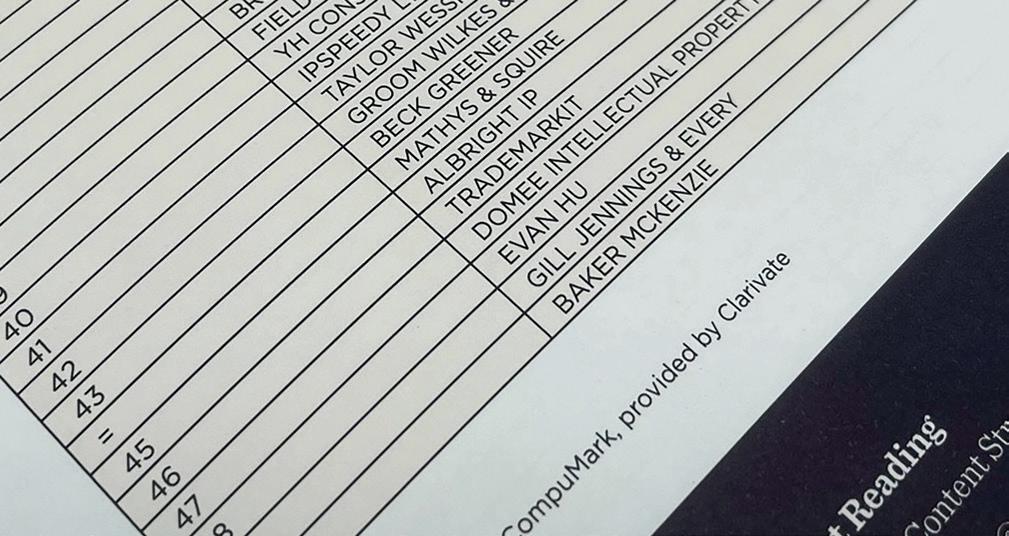
As recognised specialists in the field of Trade Mark law and practice, CITMA members are acknowledged for their in-depth knowledge and expertise. The list represents the very best in the industry.

Albright IP’s impressive ranking in the CITMA list, year on year highlights the team’s hard work, dedication and expertise in the field of trade mark law and practice.
Robert Games, Managing Director at Albright IP, commented on the achievement, saying: “Our continuing ranking by CITMA is testament to the hard work and dedication of our Trade Mark team and showcases our ongoing commitment to providing the highest quality legal services to our clients.”
Established in 2007, Albright IP currently operates with a eight-strong Trade Mark team, delivering proactive commercial advice, with great efficiency and a depth of knowledge. The firm has consistently featured in the CITMA annual list, demonstrating the team’s vast knowledge, skills and capabilities.
News
Albright IP appoints four new Directors
ALBRIGHT IP HAS ANNOUNCED THE APPOINTMENT OF FOUR NEW DIRECTORS TO ITS BOARD. CLOE LOO, FREDERICK NOBLE, MARC MAIDMENT AND DR WILLIAM DOHERTY HAVE ALL BEEN PROMOTED TO DIRECTOR POSITIONS.

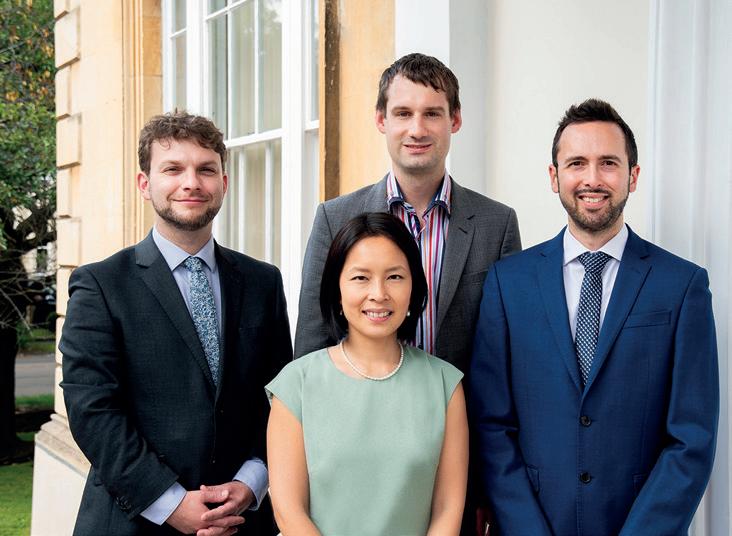
I’m looking forward to working with them at board level to continue to bring the business forward and provide exceptional service to our clients
Having been with the firm for a number of years, these individuals bring a wealth of knowledge and expertise to their roles. Their appointments further strengthen Albright IP’s commitment to delivering director-led work, a key aspect of their service offering.
In addition to the directorial appointments, Albright IP has also promoted Joel Weston and Matthew Cyrson to the position of Associate. This move is aimed at bolstering the firm’s growth and expanding its client base.
These new promotions will provide clients with increased confidence, knowing that their IP matters are being handled by senior and experienced members of the team.
Robert Games, Managing Director of Albright IP, commented: “I’m really pleased that we’ve been able to offer these four talented Patent Attorneys directorships. They are all experienced Patent Attorneys who have already made a name for themselves in the IP world while supporting
our clients. I’m looking forward to working with them at board level to continue to bring the business forward and provide exceptional service to our clients.”
The promotion of Weston and Cyrson was also highlighted by Robert, praising their respective contributions to the firm. Matthew Cyrson, has been an integral part of Albright IP’s Patent team for over seven years. He has played a key role in the firm’s response to the new Unitary Patent and has been instrumental in ensuring clients are well-informed and up to date.
Joel Weston, who specialises in Trade Marks, has excelled in handling complex opposition work for clients. With over 18 months of experience as a qualified Trade Mark Attorney, he has achieved great success in this area.
With these strategic appointments and promotions, Albright IP is well-positioned to continue delivering high-quality, director-led services to its clients, further solidifying its reputation as a leading player in the intellectual property sector.
26 FIGURE 1 MAGAZINE | ISSUE 08 News
Cloe Loo
Marc Maidment
Dr William Doherty
Frederick Noble
ALBRIGHT IP IS THRILLED TO CELEBRATE THE REMARKABLE ACHIEVEMENTS OF CHARLIE HEAL, DR CIARA FELIX AND ALYSIA DRAPER, WHO HAVE SUCCESSFULLY PASSED A SERIES OF FOUNDATION EXAMS ON THEIR JOURNEY TOWARDS QUALIFICATION.

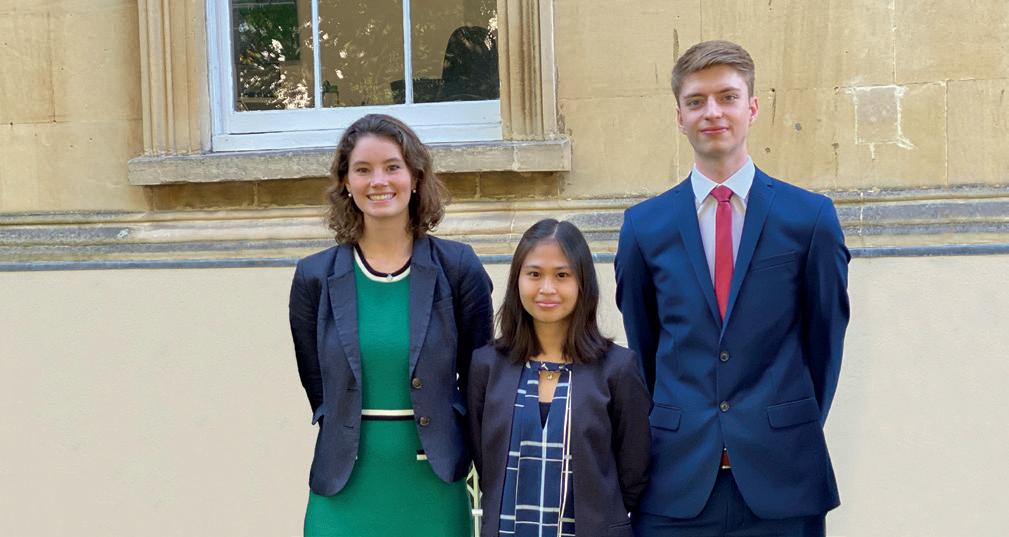
Their dedication and hard work have propelled them closer to obtaining full qualification in their respective fields.
We extend our warmest congratulations to Charlie, Ciara and Alysia on this significant milestone and applaud their commitment to professional development.
10 years Celebrating +
Their accomplishments are a testament to their talent and the support they have received from the Albright IP team.

We invite everyone to join us in recognising their outstanding achievements.
So as another two members of our team celebrate their ten-year anniversaries, we’d like to take this moment to say thank you and congratulate all our long-standing team members.
Congratulations to Reiko Hocking for 15 years of dedicated service, Cloe Loo for 13 years, Julia House for 12 years, Frederick Noble for 11 years, and both Dr William Doherty and Julie Newman for reaching the ten-year milestone at Albright IP!
We appreciate their commitment and hard work, and their role in the success and growth of Albright IP.
AT ALBRIGHT IP, WE KNOW WE ARE ONLY AS GOOD AS OUR PEOPLE, AND WE COUNT OURSELVES LUCKY TO HAVE SOME OF THE BEST TALENT IN THE SECTOR.
Alysia Draper
27 www.albright-ip.co.uk
Dr Ciara Felix Charlie Heal
Our Values
ineverything EXCELLENCE
Head Office: County House, Bayshill Road, Cheltenham, Gloucestershire GL50 3BA
T: +44 (0)1242 691801
E: info@albright-ip.co.uk
www.albright-ip.co.uk
To opt out, email: figure1@albright-ip.co.uk
i n e v e r y t h ing NART S P A R ENT toeveryone
inallma ers COMMERCIAL t o e v e r y c l tnei CO M M I T T DE toeveryone
RESPONSIVE
PERSONABLE







 FIGURE 1 TALKS TO LOUISE SANDERS, A FINANCIAL SERVICES AND ADVERTISING PROFESSIONAL, WHO FOUND HERSELF DELVING INTO THE WORLD OF INVENTION WHEN SHE BECAME A MOTHER.
FIGURE 1 TALKS TO LOUISE SANDERS, A FINANCIAL SERVICES AND ADVERTISING PROFESSIONAL, WHO FOUND HERSELF DELVING INTO THE WORLD OF INVENTION WHEN SHE BECAME A MOTHER.








 Marc Maidment PATENTS DIRECTOR
Marc Maidment PATENTS DIRECTOR






















